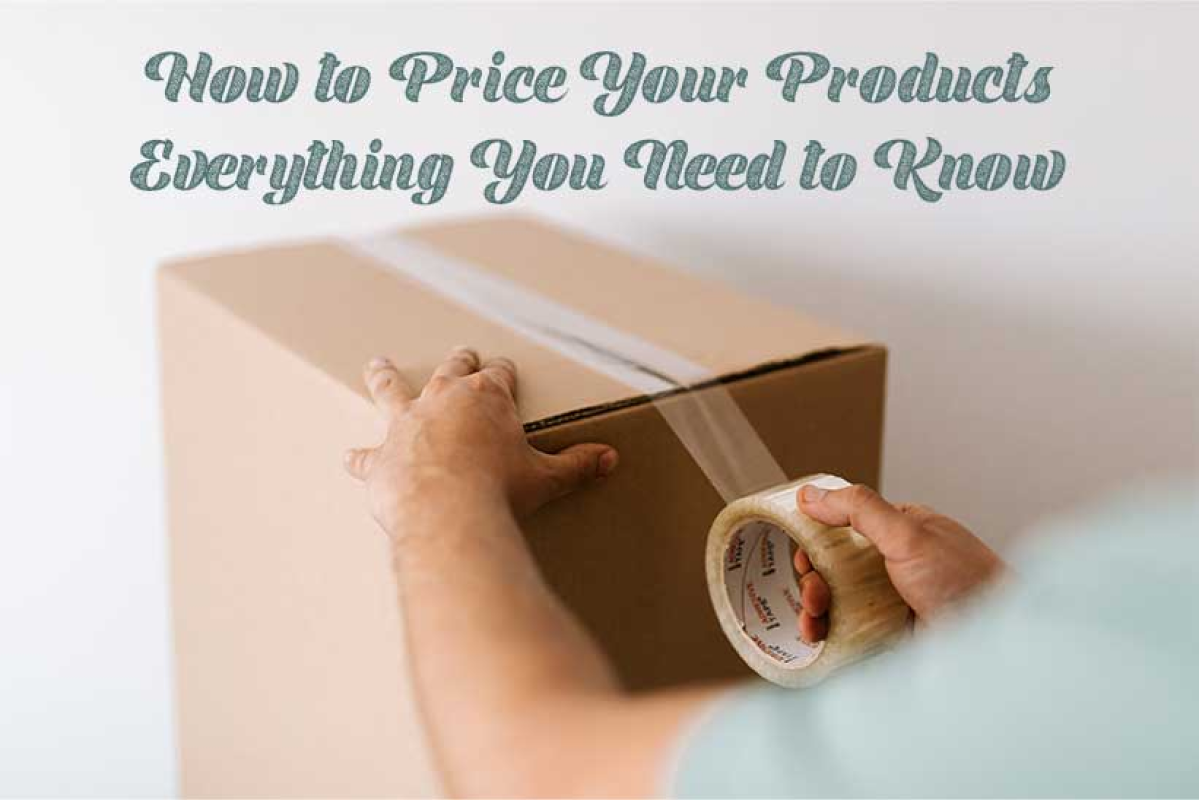How to Price Your Products: Everything You Need to Know
The excitement of adding a new product to your inventory can quickly be overshadowed by the worry of exactly what price you should set your products at.
Overprice, and you may price yourself out of the market and therefore won’t make any sales. Underprice, and your target audience may consider your product too cheap to be good quality – and so you still won’t make any sales. At the other extreme, you may make plenty of sales but a dismal profit which will not sustain your business! Pricing your products is all about striking a balance, but of course, that’s often easier said than done. Understanding how to price your products is the foundation from which your business will prosper. There is no magic formula to pricing your products because this will depend on several factors: Your product Your production costs and business expenses Your target market Your revenue goals Your competitors’ price-points Every business will have a different set of answers to these key factors, but even then, how to price your products doesn’t just come down to the numbers. In fact, number-crunching is likely to be the easiest part of the whole process. It’s actually very straightforward to work out the price of your product in theory because it’s a very simple equation based on your desired profit margin (your selling price minus your costs): How much profit do you want to make? Let’s say $5 per unit sold What are your total product costs and expenses? Let’s say $20 per unit. Break-even selling price: $20 (your total outlay) Selling cost to make $5 profit per unit: $25 You must realise that the price of your product is what will sustain your business and so a decent profit is essential. If you’re running at a loss or only ‘turning money’ (breaking even), then scaling your business is going to be a long and challenging road. So, in theory, you will price your product taking into account your desired profit. But, how do you know that you will be able to price your product at, for example, $25 and it will sell at that price-point without difficulty? You don’t. Not without considering all the other factors involved when you decide how to price your products. But before you decide on your product pricing strategy – and there are a few – there’s one super important point you must look at as a priority using information that is easily accessible to you for free.
How Much is Your Target Customer Willing to Spend on Your Product?
You should never try and price your products without first doing some market research. Yes, this can be time-consuming, but it’s a step worth taking because understanding what price your target market is willing to pay for your product is key. First, use your competitors’ prices as a starting point to gauge the market. You must choose like-for-like products to get an accurate comparison. Next, conduct an informal poll or survey via email or social media asking people in what price range they would be willing to pay for the product (hypothetically). You can even instruct a third-party agency to gather this type of market data for you. The information you are seeking when deciding how to price your products is an idea of what the majority of your target audience will expect to pay for your product. During your research, it’s likely that the price you end up with could be across a wide range, but this gives you starting parameters to work within, and you can use this information to help you with your product pricing strategy. Essentially, whatever pricing strategy you use, as long as it falls within your researched parameters, then it’s worth testing. Remember, your final price is not set in stone! Just because you launch a product at one price doesn’t mean you shouldn’t tweak it – in fact, it’s likely you will have to make tweaks due to customer demand, a fluctuation in fees or expenses and of course how your competitors behave. Staying on top of your product pricing game requires you to keep a close eye on your customers buying habits and being prepared to reprice when appropriate. So, once you have your pricing parameters gleaned from your initial market research, how should you decide on your product price?
How to Price Your Products: 5 Things to Consider
1. Know Where the Market is Heading
Do you regularly look up industry news, read white papers, keep track of market trends and the introduction of new or improved products? If you don’t, how will you spot patterns that may impact the demand or future sales of your product – and ultimately your pricing? A change in the market is one of the main factors which is likely to prompt you into making a price tweak. For example, if your product is seasonal, such as summer clothing, one lousy season weatherwise will influence sales – and prices. If you’re in the beauty niche and a specific ingredient or product is re-regulated, you may have a limited period to sell the current stock. If your product is not environmentally friendly, you may have to make modifications to the price to appeal to the ever-evolving needs of the eco-conscious public. Factors will always vary considerably from niche to niche, so it’s vital to be on the ball and make changes to your prices based on informed decisions derived from current market trends.
2. Monitor Your Prices
Not only should you be monitoring the market and know where it’s heading, but also your product prices on an individual basis. In other words, singularly, are each of your products profitable? This is different from looking at your profitability as a business as a whole. Remember that your revenue goal – which is part of how you decide on your profit – should be contributed to by all products, not just one or two best sellers. Monitoring your competitors’ prices is the easiest way to stay informed of price fluctuations which will in turn help you work out how to price your products. You don’t have to eye-ball them every day but making some necessary checks once a week is enough for you to catch any significant price changes and to investigate the reasons behind them. You should also get feedback on your pricing from your customers regularly. Send an email, invite them to a poll or survey in exchange for a voucher or other incentive. Your real customers’ opinions count as they have already invested in your product. The bonus is that in doing this, you will also be proving that you actually care about your business, your reputation and your customers.
3. Raise Your Prices Regularly
So, let’s assume that you have set your pricing, you’re keeping abreast of your competitors, are aware of any new to market products and your product is selling at a steady rate. Should you raise your price – or is that a risky move? The straight answer is that you should never be afraid to test new prices, offers or combinations (such as bundles – more on that shortly) that will potentially help you sell more products and ultimately increase your profit. There is likely to come a period in your business that you will need to raise your prices anyway because if you don’t, you are not managing your business with any real thought for the future. So, raise your price and test new offers every month and monitor any uptake or slow down in orders generated. You’ll see a reaction pretty quickly either way, but it’s worth noting that you’ll find price increases are accepted more readily in good economic times! What’s really interesting is that if you see your competitors increasing their prices in line with yours you know you’ve made a positive change that works! If a particular price or offer doesn’t work – don’t panic, just try something new. Continually testing and monitoring is essential so that you remain competitive within your niche – but you also make the profit you deserve. Tip: Don’t alienate your customers by sharply increasing your prices overnight. Make small increments over some time rather than a giant leap. It’s less noticeable, won’t scare customers off and is more readily accepted!
4. Lower Your Prices Only When Necessary
Lowering prices is generally not a good strategy – unless it’s done for strategic reasons. For example, you may want to try and grab the market share quickly and having a super competitive price will do that. Maybe your competitors have all lowered their prices, and you are merely following suit – although that doesn’t necessarily mean you should. Perhaps you have excess stock to get rid of or a discontinued line. These are all legitimate reasons where you may feel that you have to lower your price. The practice of raising your prices and testing different offers won’t be a success all the time. If you price too high, you will potentially miss your target audience, but that doesn’t necessarily mean you must automatically lower your pricing to the original. Instead, keep your price high, but add something for free to tempt consumers to try your product. This also does the job of generating interest in your product and of course, your website. Everyone likes getting something for nothing so by adding a freebie, your customer feels like they are getting more value for the higher price they are paying – and they are not so concerned about paying it!
5. Use the Bundling Pricing Strategy
‘Bundling’ happens all the time, right under your nose, yet it’s likely you don’t even recognise it as such. It’s where you see multiple products sold as a bundle, for a single price. For example, a pack of three t-shirts, or five pairs of socks, two pillows. Or related products such as a brush and comb set, shampoo and conditioner and sometimes complementary products such as a handbag and a purse or a handheld computer console with a game. A study by Harvard Business School found that bundles of related products can help products sell better – and you can use this strategy to increase your price based on ‘perceived value’. Perceived value is simply the customers’ evaluation of a product or service in comparison with similar products. When a customer feels they are getting value they are less inclined to be as concerned over the price, so you can bundle multiple products together and set your price accordingly – often higher than your competitors – and still make sales. The further advantage is that you are then offering something unique, making it harder for shoppers to compare prices like for like. Bonus Tip: Don’t forget to regularly re-evaluate your costs too! To be able to price and sell at a profit, you must buy your stock at the right price. If you are struggling to sell at an acceptable profit, look at negotiating with your supplier so that you have a more significant margin, or look at the other costs and fees involved in your break-even price. If you can lower those, you’ll have more wiggle room when it comes to working out how to price your products.

